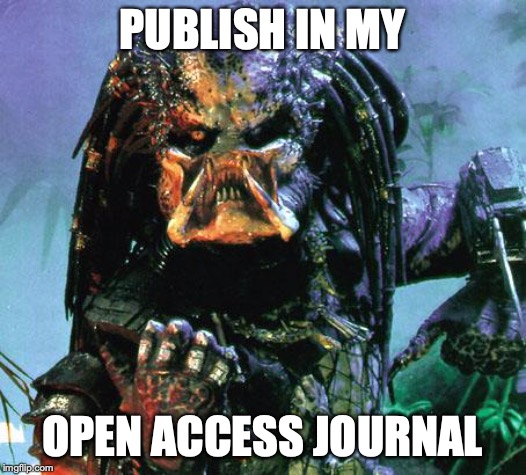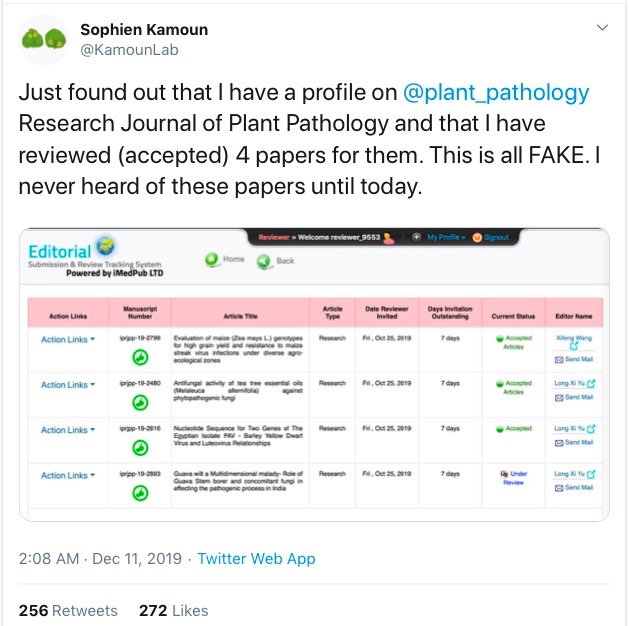If you are reading this blog, you understand that publishing scientific papers is important. Publishing can be what stands between you and your MS or PhD, getting a good postdoc, landing the next job, getting the next grant, or being tenured or promoted. We have all read about authors acting badly under the pressure of publishing or chasing high impact papers. Retraction Watch is full of such stories. But what about when it is the journal that is acting dishonorably? It happens, seemingly more and more!

Former University of Colorado librarian Jeffrey Beall started to keep Beall’s List in 2012 on Scholarly OA, a blog that included a list of journals and publishers that he considered to be predatory. The site is gone now, having been taken down by Beall in 2017, but it seems that the list is being maintained and expanded by Stef Brezgov at another website. Beall received some criticism for his ambiguous definition of predatory. But the sentiment was generally that a predatory publisher is one who runs predatory journals, which have more than one of the following characteristics:
- Peer reviews that happen too fast to be credible
- Peer reviews are not legitimately critical
- Acceptance of any manuscript, regardless of rigor or quality
- They charge a fee
- They mimic or impersonate established journals
- Unknown or fabricated editorial boards
- Fake impact factors
Today I saw on Twitter that a journal called Research Journal of Plant Pathology, published by iMedPub LTD, had been claiming that Sophien Kamoun, a prominent plant pathologist, had been reviewing manuscripts for them, when this was not the case.
The Twitter account of Predatory Journals stated “We have never seen this before. This is truly SHOCKING. It’s a whole new issue.”
It appears to be an outright fraud, like when predatory journals have fake editorial boards, to convince would-be authors that the journal is legitimate because it is embraced by mainstream scientists. The fee for publishing in this journal is $619 US.

Just today there was a “Comment” article about predatory journals in Nature. A meeting of 43 participants representing professional society publishers, funding agencies, researchers, policymakers, academic institutions, libraries and patient partners got together to define predatory journals. They came up with the following definition, which I quote:
“Predatory journals are driven by self-interest, usually financial, at the expense of scholarship. They are characterized by the following:
False or misleading information. … fake impact factors, incorrect addresses, misrepresentations of the editorial board, false claims of indexing or membership of associations and misleading claims about the rigour of peer review.
Deviation from best editorial and publication practices. … include not having a retraction policy, requesting a transfer of copyright when publishing an open-access article and not specifying a Creative Commons licence in an open-access journal.
Lack of transparency. … Predatory publishers often fail to provide their contact information or details about article processing charges. Editors and members of their editorial boards are often unverifiable.
Aggressive, indiscriminate solicitation. … such as repeated e-mails. … excessively flattering in tone, or might mention researchers’ past publications while noting that related submissions are urgently needed for a forthcoming issue. A clear warning sign is that the invitee’s expertise is outside the journal’s scope.”
Speaking of Nature, can a mainstream, legitimate publisher also be considered to be predatory? I saw just such an accusation a few days ago (I think it was on Twitter, and if I find the source I will update). The case in point was Nature Communications. This is a journal with a $5380 article processing charge (APC). Wow! On the Springer-Nature website, you can see the following explanation in the FAQs:
“What is an APC and what are authors paying for?
As costs are involved in every stage of the publication process, from administrating peer review to copy-editing and hosting the final article on dedicated servers, authors are asked to pay an article processing charge (APC) in order for their article to be published open access under a Creative Commons licence.”
Springer-Nature has nearly 600 open access journals, and for the 454 with APC listed on their downloadable Excel file (143 of them say “see website”). The range goes as low as $690 for the International Journal for Educational Integrity, up to Nature Communications, the highest priced journal. The average price of the 454 journals is $2184 (SD = $694).
The APC for Nature Communications is roughly 2.5 times the “average” APC. Is it really possible that the cost to publish is 2.5 times higher than average? Maybe, but it is hard for me to see how it could be. While I am focusing on Nature Communications here, I’m not intending to single them out, as there are quite a few other high priced Open Access journals. (Like $2000 is not high priced? Come on. Tell that to faculty who are between grants or are at primarily undergraduate institutions. But, I digress) My gut feeling is that these journals are charging more not because their costs are higher, but because they know authors will pay for the prestige of publishing in Nature Communications and its peers. I’m not alone in this. Shaun Khoo wrote that:
“When choosing a journal, the most important factor is the journal’s ‘prestige’ value. This might be related to its impact factor, its editorial board, or if it is backed by a respected society or institution. These factors are commonly believed to be important for hiring, promotions and funding applications.
The importance of journal prestige for career advancement gives researchers a strong incentive to publish in the highest ‘quality’ journals that they can. And since higher quality open access journals are associated with higher APCs, it actually encourages authors to spend more on publishing.”
So, back to the question of whether a mainstream, legitimate publisher can also be considered to be predatory. Whether these journals intend to or not, they are preying on people’s desire, or even desperation, to have a high impact publication, much like the shady predatory journals are preying on people’s desire or desperation to have any publication.
What do you think about predatory journals, open access fees, and the like? Leave a comment below!

0 Comments